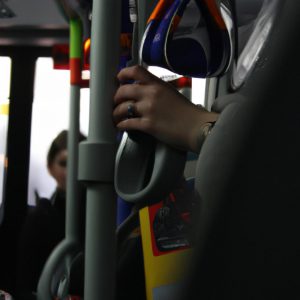Trains: A Comprehensive Guide to Transportation Options in the Travel Directory

Trains, an integral mode of transportation with a rich history dating back centuries, continue to play a vital role in the modern travel industry. With their ability to efficiently connect diverse destinations and carry large numbers of passengers or cargo, trains offer a comprehensive alternative for travelers seeking convenient and sustainable options. For instance, imagine a traveler embarking on a journey from London to Edinburgh; opting for a train instead of other modes of transport not only provides scenic views along the way but also reduces carbon emissions compared to air travel.
This article aims to provide readers with a comprehensive guide to various aspects of train transportation. By exploring topics such as different types of trains, ticketing options, amenities onboard, and popular routes across different regions, this guide seeks to equip both seasoned travelers and novices alike with valuable information for planning their journeys effectively. Furthermore, it will delve into the advantages and disadvantages associated with train travel when compared to other forms of transportation like airplanes or automobiles. Understanding these nuances can assist individuals in making informed decisions about their preferred mode of travel based on factors such as cost-effectiveness, time efficiency, environmental impact, and personal preferences.
Types of Trains
Imagine a traveler embarking on a journey to explore the scenic landscapes of Europe. They board a sleek, high-speed train in Paris and zip through the picturesque French countryside, passing quaint villages and rolling vineyards along the way. This captivating scenario is just one example that demonstrates the allure and versatility of train travel.
Trains come in various forms, each offering unique features and catering to different travel needs. Here are some popular types:
- High-Speed Trains: These trains are designed for efficiency, whisking passengers across long distances at incredible speeds. With advanced technology and streamlined designs, high-speed trains minimize travel time while providing a smooth and comfortable experience.
- Regional Trains: Ideal for exploring specific regions or commuting within cities, regional trains offer frequent stops along shorter routes. These trains often provide glimpses into local life as they traverse urban centers, suburbs, and rural areas.
- Night Trains: For those seeking overnight journeys with minimal disruptions to their daytime plans, night trains offer cozy sleeping compartments. Passengers can relax in privacy while being transported effortlessly from one destination to another.
- Scenic Trains: Unforgettable vistas await travelers who embark on scenic train rides. These specialized trains navigate breathtaking routes through mountain ranges, coastal cliffs, or lush valleys—allowing passengers to appreciate nature’s grandeur from the comfort of their seats.
Reflecting upon these options evokes feelings of excitement, wonder, and anticipation—a sense of adventure waiting to unfold. Imagine gazing out at snow-capped peaks or meandering rivers as you glide past them aboard a luxurious train carriage. Such experiences create lasting memories that surpass mere transportation.
To further illustrate the variety available when it comes to train travel options around the world, consider this table showcasing some notable examples:
| Train Type | Region | Notable Example |
|---|---|---|
| High-Speed | Japan | Shinkansen (Bullet Train) |
| Regional | Switzerland | Swiss Federal Railways (SBB) |
| Night | United Kingdom | Caledonian Sleeper |
| Scenic | Canada | Rocky Mountaineer |
By exploring the different types of trains and understanding their features, passengers can make informed choices that align with their travel goals. The subsequent section will delve into the advantages of train travel, highlighting why this mode of transportation continues to captivate so many wanderlust-filled hearts.
Advantages of Train Travel
In the previous section, we explored the different types of trains available for travel. Now, let us delve into the advantages of train travel and why it is a popular choice among travelers.
Imagine this scenario: You are planning a trip from New York City to Washington D.C. The thought of navigating through congested highways or dealing with airport security may be daunting. However, taking a train offers an alternative that is both convenient and comfortable.
Advantages of Train Travel:
-
Efficiency: Trains generally adhere to strict schedules, ensuring prompt departure and arrival times. This reliability allows passengers to plan their journeys with confidence, knowing they can reach their destinations on time.
-
Comfort: Train cabins are designed with passenger comfort in mind. With spacious seating arrangements, ample legroom, and large windows offering scenic views, train travel provides a relaxing experience throughout the journey.
-
Accessibility: Unlike airplanes where passengers need to arrive at airports well in advance, train stations are often located within city centers. This accessibility eliminates the need for lengthy commutes to distant airports and ultimately saves valuable time.
-
Eco-friendly Option: In an era when sustainability has become increasingly important, choosing train travel over other modes of transportation significantly reduces carbon emissions. Trains consume less energy per passenger mile compared to cars or planes, making them a greener option for environmentally conscious travelers.
- Reduced stress due to predictable schedules
- Enhanced relaxation during the journey
- Increased convenience by avoiding traffic congestion
- Satisfaction derived from contributing towards eco-conscious choices
Emotional Response Table:
| Advantages | Emotional Benefit |
|---|---|
| Efficiency | Peace of mind |
| Comfort | Serenity |
| Accessibility | Convenience |
| Eco-friendly Option | Environmental satisfaction |
In summary, traveling by train presents numerous advantages that make it an appealing choice for many individuals. From efficient schedules to comfortable cabins, train travel offers a stress-free and convenient way to reach your destination. Moreover, the environmental benefits associated with trains contribute to a sense of satisfaction for those who prioritize eco-friendly options.
Transitioning into the subsequent section about “Popular Train Routes,” let us now explore some notable routes that showcase the charm and diversity of train travel worldwide.
Popular Train Routes
Transitioning from the previous section on the advantages of train travel, let us now delve into some popular train routes that travelers can explore. To illustrate this point, let’s consider a hypothetical example of a traveler named Sarah who has always dreamed of experiencing Europe’s breathtaking landscapes and vibrant cities.
One notable route that Sarah could embark on is the legendary Orient Express. This iconic journey takes passengers through several European countries, including France, Switzerland, Austria, Hungary, Romania, and Turkey. As she boards the luxurious train in Paris, Sarah would be captivated by its elegant interior and attentive service. Throughout her trip, she would have an opportunity to witness stunning natural scenery as well as visit cultural landmarks such as Vienna’s historic palaces or Istanbul’s bustling bazaars.
When it comes to train travel, there are numerous advantages that make it an appealing option for adventurers like Sarah:
- Convenience: Trains often offer direct connections between major cities and towns without requiring multiple transfers.
- Comfort: With spacious seating arrangements and amenities like dining cars and Wi-Fi access on many trains nowadays, passengers can enjoy a comfortable journey.
- Environmental Friendliness: Trains are known for being more environmentally friendly compared to other modes of transportation due to their lower carbon emissions.
- Scenic Views: Train journeys allow travelers to appreciate picturesque landscapes up close while relaxing onboard.
To further demonstrate the diversity of train experiences available worldwide, we present a table showcasing four extraordinary train routes across different continents:
| Route | Countries | Highlights |
|---|---|---|
| Rocky Mountaineer | Canada | Canadian Rockies’ majestic peaks and wildlife |
| The Ghan | Australia | Australian Outback’s vastness and red desert |
| Maharajas’ Express | India | Taj Mahal’s architectural marvels |
| Glacier Express | Switzerland | Swiss Alps’ panoramic vistas and quaint villages |
As travelers embark on these remarkable train journeys, they are sure to create lasting memories while immersing themselves in the beauty of their chosen destinations.
Transitioning into our subsequent section about “Choosing the Right Train Ticket,” it is essential for travelers to understand various ticket options available. By doing so, they can ensure a seamless and enjoyable travel experience without any unnecessary confusion or inconvenience.
Choosing the Right Train Ticket
In the previous section, we explored some of the popular train routes available for travelers. Now, let’s delve into the process of choosing the right train ticket to ensure a seamless and enjoyable journey.
Imagine you are planning a trip from New York City to Washington D.C., two bustling cities on the east coast of the United States. To make this hypothetical travel experience more engaging, let’s consider John, an avid traveler who has decided to take the train for this particular journey.
When it comes to selecting a train ticket, there are several factors that should be taken into consideration. Let’s explore them in detail:
- Fare Options:
- Advance Purchase: This fare option allows passengers to secure tickets well in advance at discounted rates.
- Off-Peak Hours: Traveling during off-peak hours can often result in lower fares compared to peak hours.
- Round Trip Tickets: For those planning a return journey, round trip tickets may offer additional savings.
- Flexible Fares: These fares allow changes or cancellations with minimal charges.
- Seat Preferences:
Consider your seating preferences when booking a train ticket:
- Window Seats: Enjoy scenic views along the route.
- Aisle Seats: Easy access for movement within the train cabin.
- Quiet Cars: Opt for designated quiet cars if you prefer a peaceful atmosphere during your journey.
-
Class Options:
Different classes provide varying levels of comfort and amenities:
| Class | Description | Highlights |
|————–|———————–|———————————-|
| Economy | Basic seating | Affordable fares |
| Business | Enhanced comfort | Complimentary meals |
| First Class | Luxurious experience | Spacious seats and exclusive lounge access | -
Additional Services:
Some trains offer extra services that can enhance your travel experience such as onboard Wi-Fi connectivity, power outlets for electronic devices, and food service options.
By considering these factors, John can make an informed decision about which train ticket to purchase for his journey from New York City to Washington D.C. Now that we have explored the process of choosing the right train ticket, let’s move on to some tips for a comfortable train journey.
Tips for a Comfortable Train Journey
Understanding the various options available for train tickets is essential in ensuring a smooth and cost-effective journey. By making informed choices, travelers can optimize their travel experience and make the most of their time on board. In this section, we will explore different types of train tickets and provide insights into selecting the right one based on individual preferences and travel needs.
Types of Train Tickets:
When it comes to choosing the right train ticket, there are several factors to consider. Let’s take a moment to examine some common types:
-
Single Journey Tickets: These tickets are ideal for travelers with specific destinations as they allow for a one-way trip between two designated points. They suit those who have planned out their itinerary without any anticipated stops along the way.
-
Return Tickets: For individuals planning a round trip or returning from their destination back to their point of origin, return tickets offer convenience and often come at discounted rates compared to purchasing two separate single journey tickets.
-
Season Tickets: Ideal for commuters or frequent travelers, season tickets provide unlimited travel within a specified period, such as monthly or yearly passes. These tickets not only save costs but also eliminate the need to purchase individual tickets for each journey.
-
Interrail/Eurail Passes: Designed specifically for exploring multiple countries within Europe, these passes grant access to an extensive network of trains across participating nations during a set duration. With flexibility and freedom to plan routes as desired, Interrail/Eurail passes are popular among backpackers and travelers seeking diverse experiences.
Bullet Point List (Markdown format):
- Convenience: Choose a ticket that aligns with your intended travel plans.
- Cost-effectiveness: Evaluate different ticket options based on pricing structures.
- Flexibility: Consider whether you may require changes or modifications during your journey.
- Duration: Determine if you need a ticket valid for a single trip or multiple journeys over an extended period.
Table (Markdown format):
| Ticket Type | Description | Suitable For |
|---|---|---|
| Single Journey | One-way travel between two destinations | Travelers with specific points of arrival/departure |
| Return | Round trip from point of origin | Individuals planning a return journey |
| Season Pass | Unlimited travel within a specified period | Frequent commuters or regular travelers |
| Interrail/Eurail | Access to trains across multiple countries in Europe | Backpackers exploring diverse locations |
Choosing the right train ticket is crucial in ensuring a seamless and enjoyable journey. By considering factors such as convenience, cost-effectiveness, flexibility, and duration, travelers can make an informed decision that suits their individual needs. In the subsequent section about “Train Safety Measures,” we will delve into important precautions to ensure a secure and worry-free experience onboard.
Train Safety Measures
Section Title: Train Safety Measures
Transition from the previous section: Building on the importance of ensuring a comfortable train journey, it is crucial to address the safety measures that are implemented to enhance passenger security and maintain overall safety. By examining these proactive steps, we can gain valuable insights into how rail operators prioritize the well-being of their passengers.
Case Study Example: Consider an instance where a train experiences sudden braking due to an obstacle on the tracks. In such situations, one vital safety measure is the implementation of automatic emergency brakes (AEBs). AEB systems detect unexpected obstacles or imminent collisions and promptly initiate braking actions to prevent accidents. This advanced technology has proven effective in minimizing potential harm to both passengers and railway staff.
To further emphasize the significance of prioritizing passenger safety, let us explore some key safety measures commonly employed by rail operators:
- Emergency Communication Systems: Trains are equipped with reliable communication systems that allow passengers and crew members to report emergencies, request medical assistance, or notify authorities regarding suspicious activities.
- Surveillance Cameras: Strategically placed surveillance cameras monitor various areas inside trains and at stations. These cameras aid in deterring criminal behavior while also providing valuable evidence for investigations if incidents occur.
- Fire Suppression Systems: Trains are installed with efficient fire suppression systems that use advanced technologies like smoke detectors, fire alarms, and extinguishers. Such measures ensure quick response times in case of any fire-related hazards.
- Regular Maintenance Inspections: Rail operators conduct routine inspections and maintenance checks on their rolling stock equipment to identify potential safety risks. This practice helps ensure that trains remain structurally sound and free from mechanical issues that could compromise passenger safety.
Let us now delve into a comparison table showcasing different types of train safety measures adopted across various locations:
| Safety Measure | Description | Location |
|---|---|---|
| Emergency Stop | Allows passengers to instantly halt the train in case of emergencies | United States, Europe |
| Platform Screen Doors | Physical barriers between platforms and tracks for added safety | Asia |
| Passenger Safety Education Programs | Informative sessions on emergency procedures and safe travel practices | Australia |
| On-board Security Personnel | Trained staff responsible for maintaining security and passenger well-being | Middle East |
Through these various safety measures, rail operators aim to create a secure environment that prioritizes passenger well-being. By constantly evolving their protocols and adopting advanced technologies, they are better equipped to anticipate potential risks and ensure timely responses.
In considering the importance of train safety measures, it becomes evident that proactive steps taken by rail operators contribute significantly to fostering a sense of security among passengers. As we continue exploring transportation options in this comprehensive guide, let us remember the crucial role played by such safeguards in providing a reliable and worry-free journey.








